The Universe Would Be Very Different Without Dark Matter
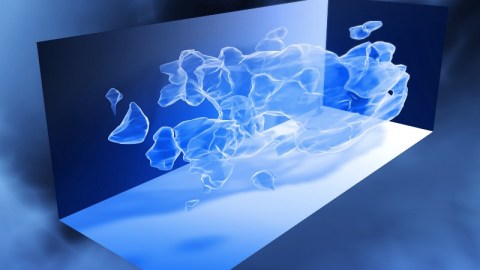
It really is the ‘glue’ that holds the Universe together, enabling structures like our own galaxy to form in the first place.
One of the most puzzling and counterintuitive facts about the Universe is that all of the “stuff” that’s familiar to us in our day-to-day lives on Earth makes up just 5% of all that’s out there. The protons, neutrons, and electrons that make up all the normal matter found in our bodies, the planet, the Solar System and throughout the galaxy make up only a fraction of what’s out there. Even when you budget in everything else that we’ve ever detected — neutrinos, light, even black holes — it leaves out 95% of all that must be out there: dark matter (27%) and dark energy (68%).
Dark matter, in particular, is one of the greatest mysteries of all. Astrophysicists are practically certain it must exist, as the indirect evidence for it from a whole suite of independent measurements is overwhelming. Because we’ve never directly detected whatever particle might be responsible for it, many people — experts and laypersons alike — remain skeptical of its existence. But if our Universe didn’t have any dark matter, it would be a very different place. Here’s how.
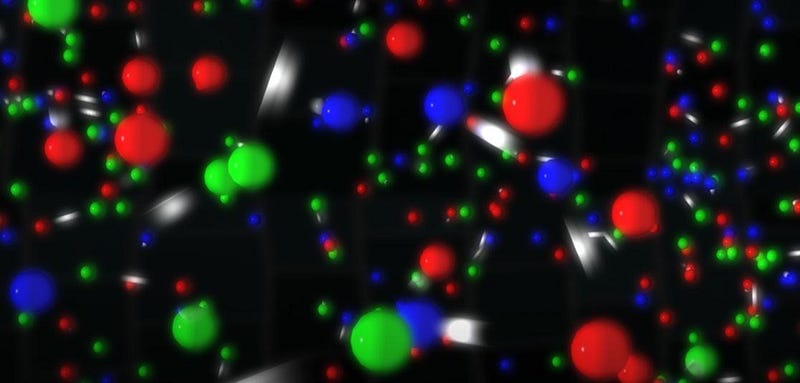
13.8 billion years ago, the hot Big Bang would still have occurred. Particles and antiparticles would have been created and destroyed in great abundances, leaving a tiny amount of protons, neutrons, and electrons left over amidst a sea of radiation. In the early Universe, it’s so hot, dense, and energetic that protons and neutrons can fuse together to form heavy elements for the very first time, with energetic particles and photons working against that process, blasting fused atomic nuclei apart again.
With no other ingredients at play, there’s only one factor that will determine what sorts of elements the Universe — before it ever forms any stars — will be filled with: the ratio of how many photons (or quanta of light) there are for every baryon (protons and neutrons combined) in the Universe. Whether you have dark matter or not is irrelevant; this is the one factor that determines how much hydrogen, helium, lithium, etc., are created in the hot Big Bang.
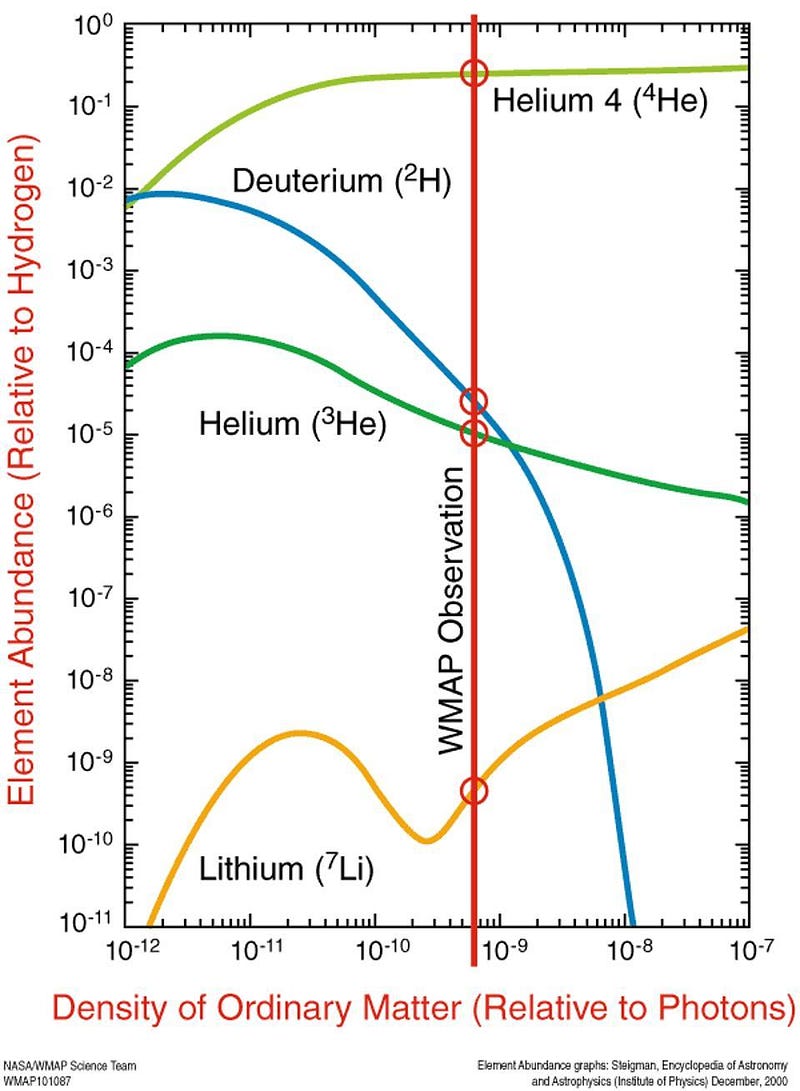
But once the first few minutes have gone by, the presence or absence of dark matter becomes enormously important. The early Universe is almost perfectly uniform, with roughly the same average density everywhere in space. But there are minuscule fluctuations — imperfections in the Universe — that will gravitationally grow with time, eventually giving rise to stars, galaxies, clusters of galaxies, and even larger structures.
Gravitation works to collapse the matter in the Universe, while radiation pushes back against these dense structures, working to drive them apart. If all you had in the Universe was normal matter and this radiation, this would lead to an enormous amount of structure on certain scales, while simultaneously wiping out all structures on other scales. This effect is maximized in a Universe with no dark matter.
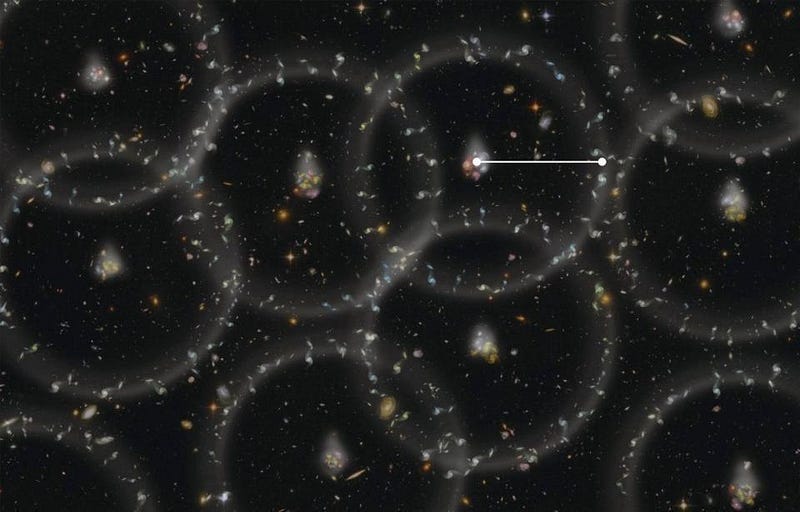
The Universe would still expand and cool while all this occurred, which means that the smallest cosmic scales will experience this collapse-and-pushback phenomenon at earlier times than the largest cosmic scales. This effect is extremely important before the Universe has cooled enough for the Universe to form neutral atoms, which means that a map of the fluctuations in the Big Bang’s leftover glow — the cosmic microwave background — will reveal these oscillations.
In particular, you can measure the temperature differences between any two locations, and see how the average difference varies dependent on the distance between those two locations. The effects of this collapse-and-pushback, what scientists call baryon acoustic oscillations, will appear in this pattern of fluctuations.
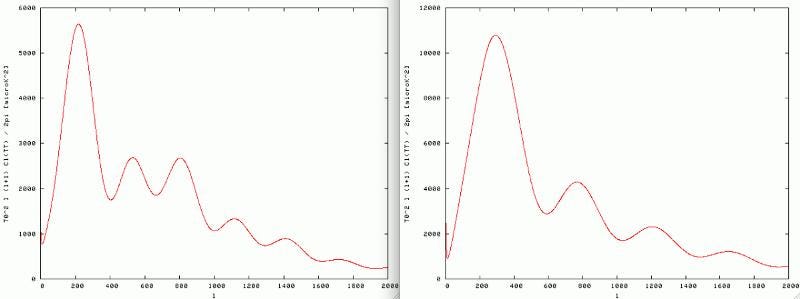
Once neutral atoms form, the pushback from radiation stops, and gravitation is free to do what it does best: attract every mass in the Universe to every other mass in the Universe. Clouds of gas would form, collapse, and create the very first stars in the Universe, same as they do in our dark matter-rich Universe.
But without the additional gravitational effects that dark matter adds, those first stars would cause a catastrophe. Stars don’t just emit visible light, but large amounts of ultraviolet, ionizing radiation as well. They emit jets of particles and blow off large amounts of fast-moving matter in the form of stellar winds. And for the first stars of all, which are much more massive than today’s stars, these effects are even more severe.
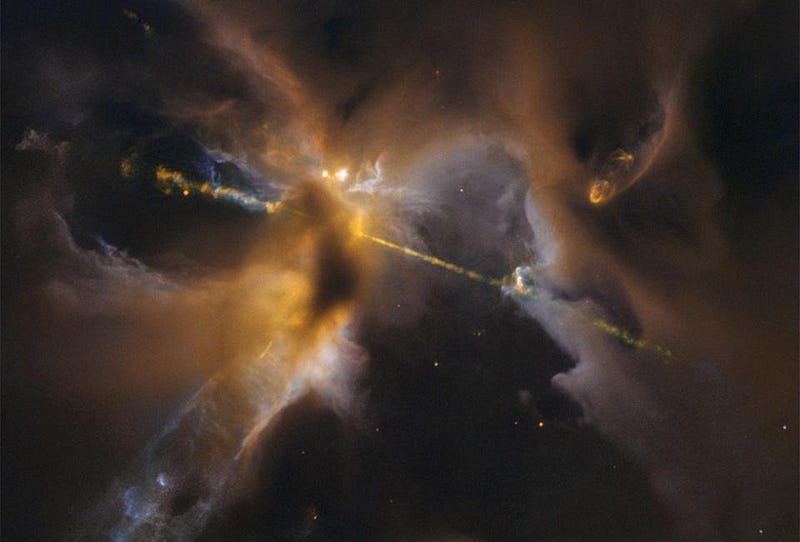
Without dark matter, the joint effects of stellar winds and ultraviolet radiation would impart such a strong “kick” to the surrounding matter that it wouldn’t just get blown back into the interstellar medium, but would become entirely gravitationally unbound from the massive star cluster that just formed.
When these stars further evolve and die, which likely means a supernova for most of these early-generation stars, the ejecta from these stars moves so quickly that — again, without dark matter — they become gravitationally unbound from the remaining material that collapsed to form these stars in the first place. Unlike our Universe, where material that was fused in one generation of stars gets recycled into the next generation, this first generation of stars might well be the end-of-the-line without dark matter.
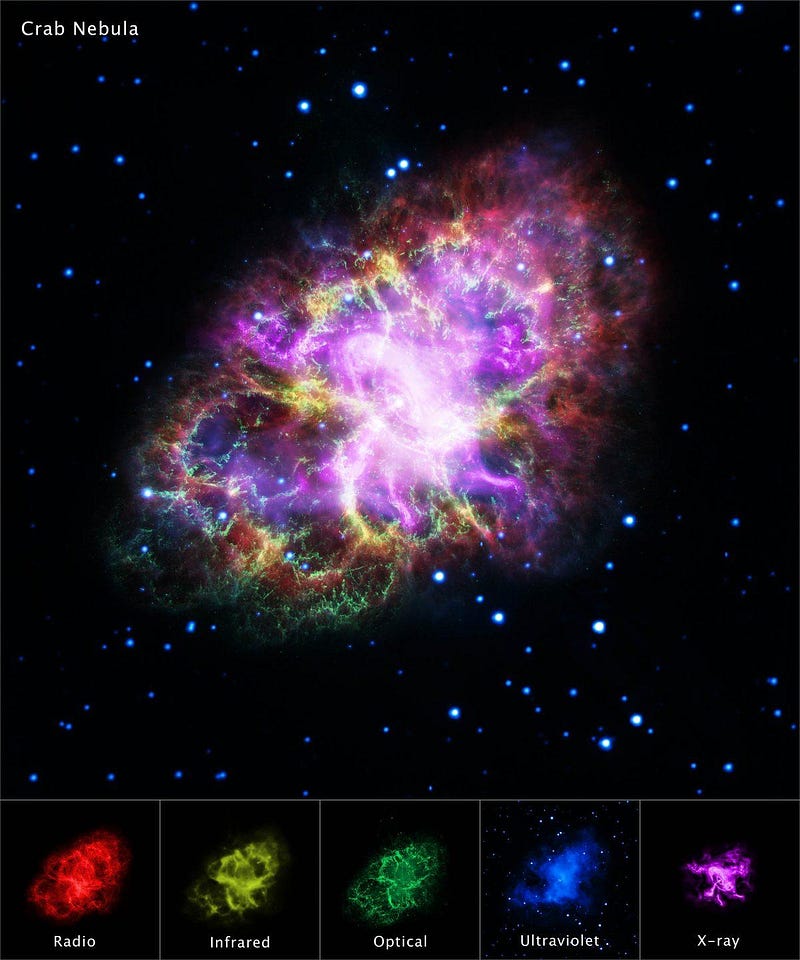
On smaller cosmic scales, that means that the only solar systems that exist will be enormously simplistic. Without the ability to recycle the elements from one generation of stars into the next, that means that you won’t have the heavy elements needed to form rocky planets in your protoplanetary disks. Without large abundances of carbon, nitrogen, oxygen and even heavier elements like silicon, phosphorous, copper and iron, not only would life be an impossibility, but the only planets you could form would be gaseous worlds composed of hydrogen and helium.
Moreover, without these heavier elements to help cool proto-stars as they form, the stars that exist will be much fewer in number but larger in mass. Today, the average star in the Universe is about 40% of the Sun’s mass; without dark matter, the average star would be approximately 10 times as massive as our Sun is.

On the scales of Milky Way-like galaxies, there would still be large collections of mass that formed disks, and those disks would still rotate and be littered with stars. But without dark matter, these galaxies would exhibit two major differences from the galaxies we see today.
- Without dark matter, galaxies would lose a large fraction of the gas that forms new stars immediate after the first major star-forming event they experienced. Gas could still funnel into them from minor mergers and the surrounding intergalactic medium, but they would possess much less of the material that forms new stars than modern galaxies do.
- Spiral galaxies, without dark matter, would rotate like our Solar System does: with the inner objects rotating much more quickly around the center than the outer objects do.
The fact that the overwhelming majority of galaxies have flat rotation curves, where the outer objects move with the same speeds as the interior ones, is another consequence of dark matter in our Universe.
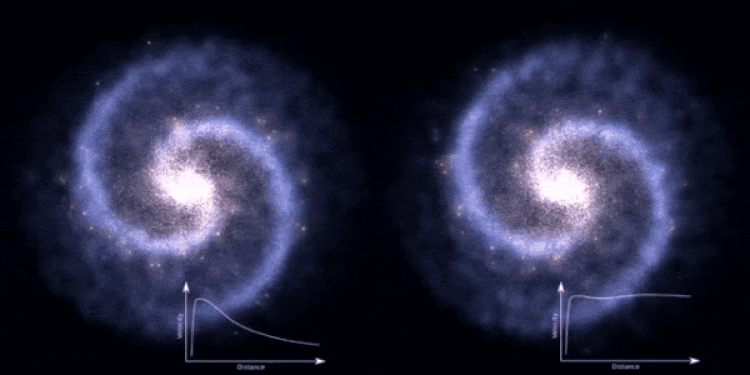
On larger cosmic scales, there would be dramatically less structure overall. In a Universe without dark matter, there is no unseen “skeleton” to the cosmic web; instead, structure forms based on the strength of normal matter alone. This means that instead of a cosmic web, where you wind up with galaxies dotting the filaments that connect the great clusters of the Universe together, you’d just wind up with isolated islands of mid-sized galaxies, with not much else.
Sure, some galaxies would still group and cluster together, but there would be far less of them that do so in a Universe without dark matter. Observations of the large-scale structure of the Universe would be enormously different by every measurable metric, from weak and strong gravitational lensing signals to galaxy group collisions to the power spectrum of the Universe.
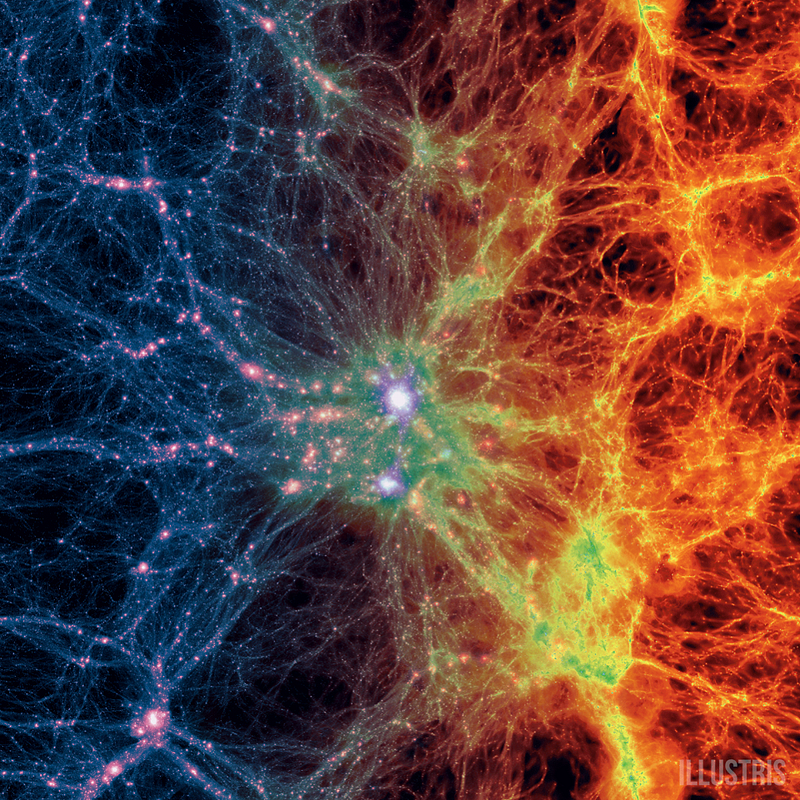
Finally, the smallest galaxies of all — the ones that contain only hundreds or thousands of stars — wouldn’t be able to exist at all. In our Universe, they arose from a clump of normal-and-dark matter of approximately 100,000 solar masses, where an episode of star formation ejected the gas. Still, the dark matter persisted, and holds the stars together in their own bound structure even to the present day. In a Universe without dark matter, that same episode of star formation would blast the proto-galaxy apart entirely, leaving only a slew of individual, unbound stars behind.
There are many different lines of evidence that point towards dark matter’s existence, but it’s perhaps a little more interesting to consider all the ways our Universe would be different — and inconsistent with what we observe — if it had no dark matter at all. If you enjoy the fact that the Universe is held together as well as it is, you have dark matter to thank for it. Even if you don’t believe in it, it’s a key ingredient in the Universe that led to you.
Ethan Siegel is the author of Beyond the Galaxy and Treknology. You can pre-order his third book, currently in development: the Encyclopaedia Cosmologica.





